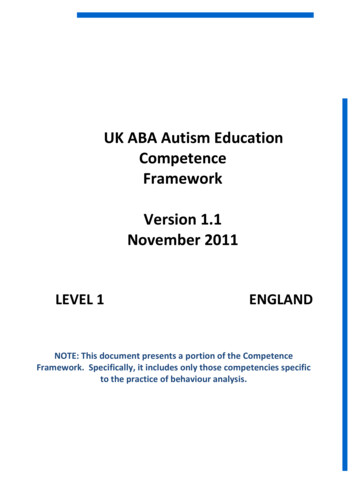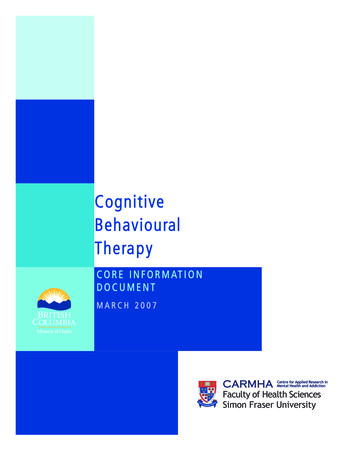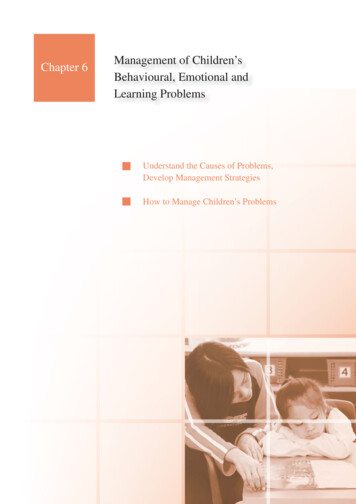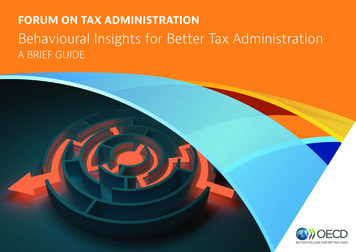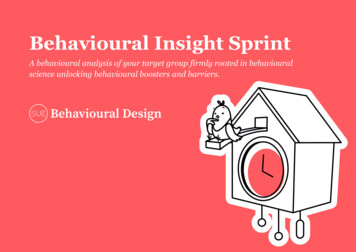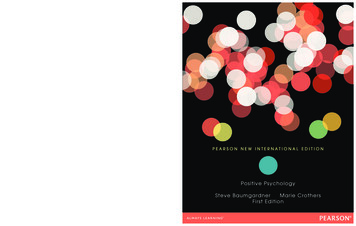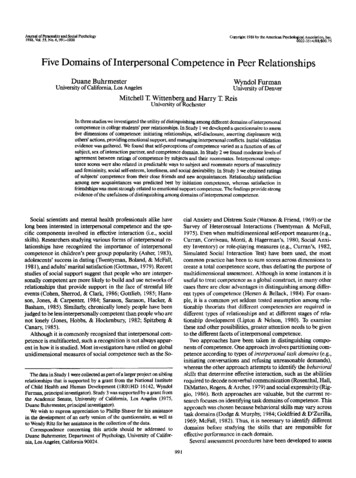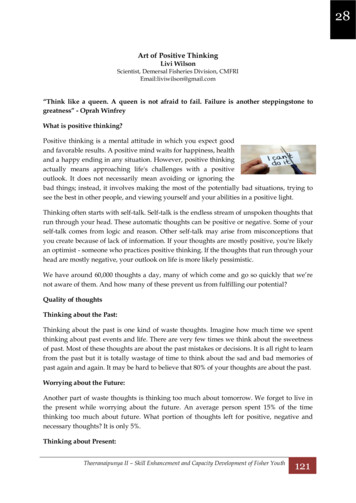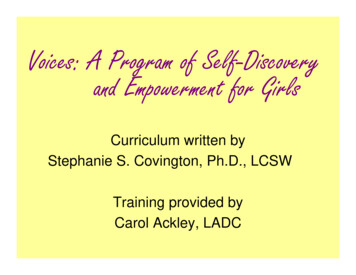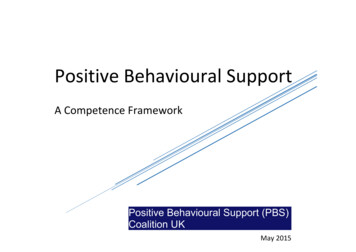
Transcription
Positive Behavioural SupportA Competence FrameworkPositive Behavioural Support (PBS)Coalition UKMay 2015
The Positive Behavioural Support Competence Framework has been produced by the PBS Coalition - a collective of individuals andorganisations promoting PBS in the UK. The Framework is licensed under a Creative Commons Attribution-ShareAlike 4.0International License.All organisations and individuals are welcome to use the PBS Competence Framework and to remix, tweak, and build upon thecontent even for commercial purposes, as long as they credit the PBS Competence Framework and the work of the PBS Coalitionand license their new work under the identical terms.The Framework is available on the PBS Coalition blog: http://pbscoalition.blogspot.co.uk/We are delighted that the PBS Competence Framework has been endorsed by the following organisations. Whilst this does notimply that each organisation is necessarily demonstrating all of the competencies required of quality provision as outlined in theframework, our expectation is that this suggests a commitment to its implementation.2PBS Competence Framework 2015
3PBS Competence Framework 2015
Challenging BehaviourCommunity of PracticeImpactChangeCymuned YmarferYmddygiad HeriolInformEffeithioNewidRhoi GwybodContents4PBS Competence Framework 2015
What is Positive Behavioural Support (PBS)?6Why use PBS?10When and for whom might PBS assessment and intervention plans be needed?11How is PBS implemented?12What is the PBS Competence Framework?13The PBS Competence FrameworkCreating high quality care and support environments20Functional, contextual and skills based assessment39Developing and implementing a Behaviour Support Plan (BSP) &Evaluating intervention effects and on-going monitoring49References67Acknowledgements725PBS Competence Framework 2015
What is Positive Behavioural Support?Over the last three decades, Positive Behavioural Support (PBS) has increasingly become the model of choice in supporting peoplewhose behaviour poses challenges to services. While there are a number of existing descriptions of PBS available (Allen et al., 2005;Carr et al., 2002; Horner et al., 1990, 2000; LaVigna & Willis, 2005), a recent definition by Gore et al., (2013) sought to bringtogether the fundamental elements of PBS in a way that could usefully inform future service, policy and research developments inthe UK. The key features of this definition are summarised in Table 1.Gore and colleagues emphasise that PBS is multicomponent framework for developing an understanding of behaviour thatchallenges rather than a single therapeutic approach, treatment or philosophy. It is based on the assessment of the broad socialand physical context in which the behaviour occurs, and used to construct socially valid interventions which enhance quality of lifeoutcomes for both the person themselves and their carers.The framework consists of ten elements grouped into three overarching themes of values, theory/evidence base, and process. It isimportant to stress that these elements do not represent a ‘menu’ of options. Rather, the effective implementation of PBSnecessitates the combined use of all of these elements.ValuesPBS combines the technology of behavioural intervention with the values of normalisation, human rights, and self–determinationto deliver effective person-centred support for people whose behaviour challenges. Crucially, these values inform both the way inwhich this technology is used and the outcomes that it is designed to achieve.PBS, therefore, aims to enhance quality of life as both an intervention and outcome for people who display behaviour thatchallenges and those who support them. PBS interventions are also constructional in that increasing the person’s repertoire ofadaptive behaviours and their range of positive life opportunities is a central objective. In contrast, the use of aversive or punitiveinterventions is rejected on the basis of their incompatibility with a values-led approach.6PBS Competence Framework 2015
Table 1: Key Components of PBSValues1. Prevention and reduction of challenging behaviour occurs within the context of increasedquality of life, inclusion, participation, and the defence and support of valued social roles2. Constructional approaches to intervention design build stakeholder skills and opportunitiesand reject aversive and restrictive practices3. Stakeholder participation informs, implements and validates assessment and interventionpracticesTheory andEvidence Base4. An understanding that challenging behaviour develops to serve important functions forpeople5. The primary use of constructional principles and procedures from behaviour analysis toassess and support behaviour change6. The secondary use of other complementary, evidence-based approaches to supportbehaviour change at multiple levels of a system7. A data-driven approach to decision making at every stageProcess8. Functional assessment to inform function-based intervention9. Multicomponent interventions to change behaviour (proactively) and manage behaviour(reactively)10.Implementation support, monitoring and evaluation of interventions over the long termGore, N.J., McGill, P., Toogood, S., Allen, D., Hughes, J.C., Baker, P., Hastings, R.P., Noone, S.J. & Denne, L.D. (2013). Definition and scope for positive behavioural support.International Journal of Positive Behavioural Support, 3 (2), 14-237PBS Competence Framework 2015
PBS takes account of the behaviour and wellbeing of stakeholders (such as paid and family carers) and emphasises stakeholderparticipation to ensure that assessments, interventions, and outcomes are meaningful. PBS is therefore ‘done with’ rather than‘done to’ the person and those who support them.Theory and Evidence BasePBS is founded upon an understanding that behaviours that challenge serve important functions for those who display them. Theydevelop and are maintained within the context of a person’s abilities, needs (including their physical and mental health) andcircumstances and, critically, the characteristics of the social and physical environment within which the behaviour occurs. Theseenvironments often contain or lack important features that are provocative of behavioural challenges, and the term ‘challengingenvironments’ has been used to stress that many of the causal factors behind such behaviours lie outside the person.This understanding, together with many of the assessment and intervention methods utilised in PBS, is grounded in constructionalprinciples and procedures from behaviour analysis.PBS is also an inclusive approach which incorporates additional evidence-based approaches that are supportive of its stated valuesand compatible with its overarching framework.ProcessPBS requires assessment and support arrangements to be personalised and grounded directly in information that has beengathered about the person (including their broader needs and abilities) and their environment.The PBS process begins with a systematic assessment of when, where, how and why an individual displays behaviour thatchallenges, a process known as functional assessment or functional analysis. The primary outcomes of this process are1:1. A clear description of the behaviours of concern (including classes or sequences of behaviour that occur together).1from O’Neill et al., 19978PBS Competence Framework 2015
2. The identification of the events, times, and situations that predict when the behaviour will and will not occur across theperson’s full range of typical daily routines.3. Identification of the consequences that maintain the behaviour (that is, the purposes or functions that the behaviourappears to serve for the person)4. The development of one or more summary statements or hypotheses that describe specific behaviours, the situations inwhich it occurs, and the consequences that may maintain it.5. The collection of direct observational data that support the summary statements that have been developed.Reflecting the fact that behaviours that challenge often have multiple causative factors, PBS intervention plans typically have multicomponents which are built on the findings of assessment and devised in partnership with key stakeholders. Proactive strategiesthat seek to reduce the likelihood of behaviours of concern occurring should form the majority of any plan. These will includeinterventions aimed at increasing stakeholder quality of life, ones that seek to alter the contexts in which challenging behavioursoccur, and those which support the development of new skills that serve the same function as the behaviour or which enable theperson to cope more effectively with situations that they find hard to manage.A PBS plan will also describe an appropriate and ethical range of reactive strategies to guide responses to incidents of behaviourthat are not preventable and which aim to minimise escalation and reduce the risk of harm to the person and others. These shouldform a minority component of any plan, but play a crucial role in terms of making people safe.Finally, PBS plans provide guidance on how strategies will be implemented, by whom and by when. Data-based systems arerequired to monitor both the reliability of plan implementation and resulting changes in quality of life and behaviours thatchallenge.9PBS Competence Framework 2015
Why use PBS?There are four main reasons to recommend PBS as an approach to support individuals whose behaviour challenges: PBS has been developing within a variety of settings in the UK over the past three decades, and there is now a strong practicebase for its use. The values underpinning PBS are entirely congruent with those within national policy and frameworks for people withintellectual disability. There is a strong scientific evidence base for the technology that underpins PBS. Practitioner-researchers have been usingsingle case experimental designs to evaluate intervention effectiveness for several decades. These have in turn been subjectto a number of systematic reviews and meta-analyses (Campbell, 2003; Carr et al., 1990, 1999; Didden et al., 1997; 2006;Harvey et al., 2009; Marquis et al., 2000; Scotti et al., 1991). The most recent of these (Heyvaert et al., 2010, 2012) includedover 250 single case design studies and confirmed that behavioural interventions deliver positive outcomes for individualswhose behaviour challenges. There is also limited randomised controlled trial (RCT) evidence which attests to the efficacy ofPBS. One UK study in which individuals were allocated randomly to receive PBS delivered by a specialist team or input asusual showed significantly better outcomes for those allocated to the PBS arm of the trial (Hassiotis et al., 2009). Data werealso reported which suggested that the PBS support cost slightly less overall to deliver (due to reduced use of other healthservices by the participants). PBS is recommended as best practice within professional practice documents (Royal College of Psychiatrists, BritishPsychological Society & Royal College of Speech & Language Therapists, 2007) and in national policy statements. In England,for example, this includes Meeting Needs and Reducing Stress (NHS Protect, 2013) Positive and Proactive Care (Departmentof Health, 2014), Ensuring Quality Services (Local Government Association and NHS England, 2014) and A Positive andProactive Workforce (Department of Health, Skills for Health & Skills for Care, 2014), all of which champion the role of PBS inproviding effective support to people who challenge. In Wales the PBS is a key recommendation in the Welsh governmentreport by the Learning Disability Advisory Group and All Wales Challenging Behaviour Community of Practice entitled‘Transforming care for people in Wales with a learning disability and challenging behaviour: The five top priorities.’10PBS Competence Framework 2015
When, and for whom, might PBS assessment and intervention plans be needed?The aim should always be to produce a functional assessment and accompanying Behaviour Support Plan (BSP) for challengingbehaviour, irrespective of its severity or chronicity. The complexity and intensity of that assessment and plan will however varywith the complexity and intensity of behavioural challenge and should therefore follow an incremental approach.A pre-assessment that involves gathering data which helps shape the initial focus and level of any assessment work should alwaysbe completed. Key information may be provided in referral forms or letters, but will typically need supplemented by obtainingfurther details from the referring agent and key carers.For recent onset or low level behaviours, simple forms of functional behavioural assessment may be sufficient to identifyrelationships between the behaviour, antecedents and its consequences. Where there are behaviours of recent onset or markedchanges in patterns of existing behaviours, the contribution of any significant alterations in environment, physical or psychologicalhealth must be explored and appropriate interventions implemented.For more established and complex behaviours, or behaviours that do not respond to lower levels of assessment and intervention,more in-depth assessment involving combinations of informant interviews, direct observations, structured record keeping,questionnaires and reviews of case material will be required.Irrespective of the level of assessment, the person’s key carers and, whenever possible, the person themselves, should be fullyinvolved in the process and in sense checking its outcomes.Assessment of more complex behaviours should always be multi-disciplinary. The resulting formulation should be likewise withone, single account of why the behaviours are occurring being produced (as opposed to individual, uncollated professionalopinions). The formulation should integrate findings about the person, their environment and behaviour into a coherent anddynamic whole. Assessment should also involve an analysis of the strengths and needs of the person’s carers (for example, the11PBS Competence Framework 2015
resources they have available, their existing knowledge, attitudes towards the person, their current beliefs about the behaviour,and any significant health or personal concerns).Where the behaviour poses risk to the person or others, an appropriate risk assessment should also be completed.Assessment should always include a baseline measure of current behavioural rate and intensity so that repeated measurementscan be taken post-intervention to gauge change. Assessment should also involve baseline measures of quality of life and currentusage of restrictive practices (such as physical restraint, as required medication, or seclusion). Assessment should be a dynamicrather than static process because precipitating and maintaining variables may change over time. Repeat assessments shouldalways follow any change in presentation of a person’s behavioural challenges.How is PBS implemented?PBS may be implemented in at least three ways: By a single practitioner coordinating all elements of the framework and leading each stage of the process on acase-by-case basis. In team partnerships between a range of professionals and a person’s regular carers. Through system-wide approaches whereby the PBS framework is implemented at varying levels or tiers ofintensity across an entire organisation (such as schools, residential or small group homes, or specialist inpatientsettings) or geographical territory.12PBS Competence Framework 2015
What is the PBS Competence Framework?While the emphasis on PBS in UK policy is welcome, its main impact to date is that many services, agencies and trainers now layclaim to implementing this approach when their actual practice bears little or no resemblance to the model described above. Thisparallels experience in North America, where a similarly rapid promotion of PBS was associated with a misunderstanding, dilutionand corruption of the approach.The genuine implementation of PBS requires joined-up working across service sectors and within multi-disciplinary teams, ensuringthat both teams and the individuals within them understand their role in delivering this approach. It also requires the recruitmentand retention of the right people, quality training and staff development, opportunities for staff progression within services, theability to assess staff performance and evaluate service provision, knowing what to look for in a service provider, and consistency inpractice to facilitate research. Mapping these components against a shared framework of peer-reviewed competencies is one wayof supporting such joined-up working (Denne et al., 2013).The UK PBS Competence Framework therefore provides a detailed framework of the things that you need to know and thethings that you need to do when delivering best practice PBS to persons with intellectual disabilities and behaviours thatchallenge. The objectives of the framework are that: More individuals with intellectual disabilities and behaviours that challenge will benefit from high-quality, evidence-basedsupport delivered by competent professionals working as part of a multi-disciplinary team. Practitioners will benefit from professional development and occupational standards. Organisations supporting individuals with intellectual disabilities and behaviours that challenge will be able to employpractitioners with a greater degree of certainty about competence and quality. Commissioners will have a greater understanding of the nature and use of PBS in practice. Practice based research will contribute to the growing evidence base for PBS.13PBS Competence Framework 2015
Who is the framework for?The UK PBS Competence Framework is for any individual providing or procuring direct support or working with persons withintellectual disabilities and behaviours that challenge, as well as any health, education or social care professional, service provider,researcher, academic institute, government or non-government organisation and government department, responsible for theprovision of such services. This includes, for example, family carers, support workers, volunteers, teachers, behaviour analysts,psychologists, intellectual disability nurses, speech and language therapists, occupational therapists, psychiatrists, and key decisionand policy makers.How can the framework be used?The framework lists the competencies that define best practice. It is a resource that provides a common and shared knowledge andassociated actions necessary for the delivery of PBS. It could be used to help: develop a whole organisation approach to PBSdevelop a structured and progressive continuing education curriculum for all professionals involved in the delivery of PBSdevelop a structured and progressive training curriculum for PBS specialist practitionersprovide a framework for human resource management including recruitment, retention and staff progressiondevelop assessment tools with which to evaluate individual and group performancesprovide a way for consumers and commissioners to evaluate the likely quality of PBS providersprovide a way for those seeking training and professional development to evaluate training programmesprovide a baseline for research purposesAny organisation or individual may develop curricula, tools, guidelines based on the framework that meet their own needs. The aimis not to prescribe what these may look like; rather it is to provide a common basis upon which such resources may be developed.What does the PBS Competence Framework look like?The Framework is shown in table 2:14PBS Competence Framework 2015
Table 2: The PBS Competence Framework1.Creating high quality care and supportenvironments2.Functional, contextual and skills basedassessment3.Developing and implementing a Behaviour Support Plan(BSP)Evaluating intervention effects and on-going monitoring1.1Ensuring that services are values led2.1Working in partnership with stakeholders3.1Understanding the rationale of a BSP and its uses1.2Knowing the person2.2Assessing match between the person andtheir environment and mediator analysis3.2Synthesizing data to create an overview of a person’s skills andneeds1.3Matching support with each person’s capabilitiesand with goals and outcomes that are personallyimportant to them2.3Knowing the health of the person3.3Constructing a model that explains the functions of a person’schallenging behaviour and how those are maintained1.4Establishing clear roles and effective team work2.4Understanding the principles of behaviour(4 term contingency); understanding thefunction of behaviour3.41.5Supporting communication2.5Supporting data driven decision making1.6Supporting choice2.6Assessing the function of a person’sbehaviourDevising and implementing multi-element evidence based supportstrategies based on the overview and model Antecedentstrategies Antecedent strategies Developing functionally equivalent alternative behaviour (toCB) Increasing skills and communication Systems change and contextual interventions1.7Supporting physical and mental health2.7Assessing a person’s skills andunderstanding their abilities3.5Devising and implementing a least restrictive crisis managementstrategy1.8Supporting relationships with family, friends andwider community2.8Assessing a person’s preferences andunderstanding what motivates them1.9Supporting safe, consistent and predictableenvironments3.6Developing the plan; outlining responsibilities and timeframes1.10Supporting high levels of participation inmeaningful activity3.7Monitoring the delivery of the BSP g and understanding relevant legislation3.8Evaluating the effectiveness of the BSP1.12A commitment to Behaviour Skills Training3.9The BSP as a live document Arousal curveReactive strategies15PBS Competence Framework 2015
The Framework is divided into three main areas, each of which details specific competencies that need to be achieved to delivereffective support. These areas are:Creating high quality care and support environments aims to ensure that organisations, and those providing individualsupport, operate from a person-centred foundation. The purpose of person-centred support is to enable a high quality of lifefor all concerned, which includes mitigating risk factors for the development and maintenance of behaviour that challenges.The likelihood and impact of behaviour that challenges is likely to be reduced in supportive environments that meet aperson’s social, physical and mental health needs, and that facilitate engagement, communication, choice and control. Manyof the competencies described here, while having particular resonance in relation to supporting people with behaviouralchallenges, should be staple features of any high-quality service for people with intellectual disability.Functional, contextual and skills based assessment focuses more on emerging or established behavioural challenges and aimsto ensure that the support outlined for each person is based on a thorough understanding of that person’s needs,preferences, abilities, communication style, the function for them of any behaviour that challenges and how this ismaintained, and the context and resources in which and with which such support may be given.Developing and implementing a Behaviour Support Plan (BSP) also focuses emerging or established challenging behavioursand aims to provide a detailed and personalised description of how best to support each person with developmentaldisabilities and their behaviours of concern. It will include prompts to guide the behaviour of those supporting them,strategies to redesign their environment and therefore reduce challenging behaviour, and a plan to develop their skills andappropriate behaviour. The competencies relating to evaluating intervention effects and on-going monitoring aim to ensurethat a BSP continues to meet a person’s needs and is systematically adjusted in response to any changes in those needs, theperson’s skills and his or her environment.16PBS Competence Framework 2015
All of the competencies listed are necessary from the point of view of the person being supported. Regardless of provider, thenature of provision, and the number of stakeholders involved, their overall support package should therefore reflect thesecompetencies in their entirety. This does not mean that all the competencies will need to be demonstrated by every individualinvolved in that provision. While there are certain core competencies (particularly those around creating supportive environments)which will be applicable to everyone, there are also specialist competencies which will be the focus of practitioners such aspsychologists, psychiatrists, speech and language therapists, behaviour analysts and any other professional leading on PBS within aservice setting.For this reason, the framework details three levels of competencies by function: Direct contact, BehaviourSpecialist/Supervisory/Managerial and Higher Level Behaviour Specialist/Organisational/Consultant. Direct contact competencies are for all those providing direct support to persons with developmental disabilities whomay have behaviour that challenges. This may be in a paid or unpaid, professional or volunteer capacity (includingfamily members). Whilst these competencies are clearly important for those working on a day to day basis, it is likelythat anyone involved in the delivery of PBS services, including those in supervisory and strategic positions, will havehad experience of providing direct support at some point in their careers and will continue to do so from time to time,such as when providing specialist individual support. These competencies are therefore not repeated at theSupervisory and Strategic levels but will, nonetheless, be a requirement for those individuals who continue to have oreven occasionally have direct contact with persons with challenging behaviour. The Behaviour Specialist/Supervisory/Managerial and Higher Level Behaviour Specialist/Organisational/Consultantcompetencies reflect the fact that increasing levels of complexity within service delivery necessitate additionalcompetence both in terms of systems support and clinical excellence. Behaviour Specialist/Supervisory/Managerialcompetencies are for anyone involved in supporting those who provide direct contact. This may be in a supervisory(e.g., directly supervising front line staff), managerial (supporting and responsible for supervisor and front line staff) or“clinical” (responsible for assessment, devising and overall implementation of the BSP) capacity.17PBS Competence Framework 2015
Higher Level Behaviour Specialist/Organisational/Consultant competencies are the highest level and are for thoseresponsible for embedding PBS into and across services and building capacity; but also include expert clinicalcompetencies required for the most complex systems and cases.This structure, and the way in which the competencies are presented, acknowledges the fact that PBS will often be delivered bymulti-disciplinary teams. The levels are not therefore, necessarily, role specific. They are hierarchical, but only in the sense ofexpertise in PBS and they reflect the three broad functions that are involved in the implementation of PBS. For example, a clinicalconsultant depending on their role within a service, may not need or have PBS competencies at the highest level within theframework.18PBS Competence Framework 2015
PBS Practice competenciesSystems SupportBehaviour Specialist/Supervisory/ManagerialHigher Level risk complexity requires specialistcompetenciesSystems Complexity requires higher levelmanagerial/strategic competenciesDirect Contact19PBS Competence Framework 2015
Competence Area 1: Creating high quality care and support environmentsAim: To ensure organisations and those providing direct support operate from a person-centred foundation to ensure a high quality of life for individuals supported and that theyproactively address risk factors for the development and maintenance of behaviour that challenges. The likelihood and impact of behaviour that challenges is likely to be reduced inenvironments that meet an individual’s social, physical and mental health needs, and that successfully facilitate engagement, communication and choice-making.1.1DCEnsuring that services are values ledThings you need to knowThings you need to doWhy is this important?The value base underpinning modern high quality services,including:Show dignity, respect, warmth, empathy, and compassion in allinteractionsThe principles and practices of normalisation and inclusion,especially in relation to creating opportunities forincreased community presence, stronger networks ofrelationships, greater participation in ordinary activities,making a greater number of choices, developing skills, andenhancing personal dignity and respectTreat every individual as a person and provide support that is tailoredto meet needThe key focus of learningdisability support isenablement, which isdifferent from other‘hotel’ models of careand support.The principles and practice of person centred planning andactionArrange and support participation in activities of everyday lifeArrange and support participation in community activities and eventsSearch out and support the development of relationshipsArrange and support meaningful choiceThe importance and meaning of adopting the leastrestrictive approachArrange and support opportunities for learning and developmentHelp and support behaviour and daily interactions that make theperson look and feel good.Minimise any restriction of activities or movement; and use positivehandling strategies when needed in emergency situations20PBS Competence Framework 2015
SUP/MGRThe importance of establishing clear leadership in settingthe cult
Functional assessment to inform function -based intervention 9. Multicomponent interventions to change behaviour (proactively) and manage behaviour . for example, this includes Meeting Needs and Reducing Stress (NHS Protect, 2013) . report by the Learning Disability Advisory Group and All Wales Challenging Behaviour Community of Practice .

